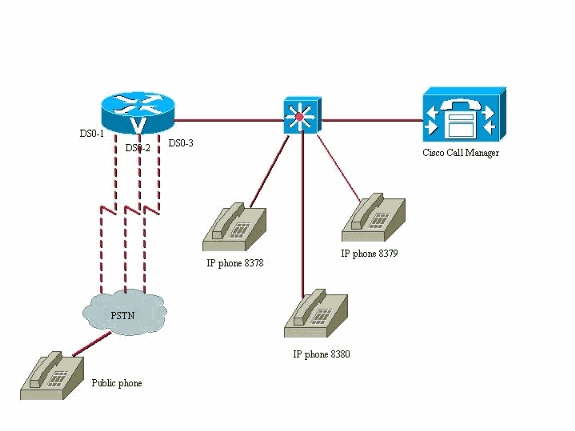Mapping Outbound VoIP Calls to Specific Digital Voice Ports
Available Languages
Contents
Introduction
This document demonstrates how to configure an analog H.323 gateway to route calls out to the Public Switched Telephone Network (PSTN) using specific DS0 ports based on the calling number of the IP phone that originated the call. Normally, a call sent to an analog gateway would have to use a hunt scheme to route calls out of the gateway, with no concern for which DS0 port is chosen to route the call outbound. In many cases, it is desirable for a specific DS0 port to be associated with a certain IP phone number so that calls going outbound only use that certain DS0 port instead of choosing a port randomly or based on some hunt method like "least idle."
Prerequisites
Requirements
There are no specific requirements for this document.
Components Used
The information in this document is based on these software and hardware versions:
-
Cisco CallManager 3.x
-
Cisco IP Phones
-
Analog Gateway ( 2600, 3600, 1700, IAD 2400)
Note: You must be running Cisco IOS® Software Release 12.2(11)T and later.
The information in this document was created from the devices in a specific lab environment. All of the devices used in this document started with a cleared (default) configuration. If your network is live, make sure that you understand the potential impact of any command.
Conventions
For more information on document conventions, refer to Cisco Technical Tips Conventions.
Configure
In this section, you are presented with the information to configure the features described in this document.
Note: To find additional information on the commands used in this document, use the Command Lookup Tool (registered customers only) .
Network Diagram
This document uses the network setup shown in this diagram.

Configure the T1 for Specific DS0 Groups
| Configuration |
|---|
controller T1 1/0 framing esf linecode b8zs ds0-group 1 timeslots 1 type e&m-wink-start ds0-group 2 timeslots 2 type e&m-wink-start ds0-group 3 timeslots 3 type e&m-wink-start |
Configure the H.323 Gateway Inbound Dial Peers
An incoming dial-peer in the gateway accepts an outgoing call from the Cisco CallManager IP phone to a specific DS0 port.
| Configuration |
|---|
dial-peer voice 1 voip translation-profile incoming DS01 answer-address 8378 !--- A call from IP phone 8378 matches this dial-peer. !--- The answer-address matches the ANI of the calling party. dial-peer voice 1 voip translation-profile incoming DS02 answer-address 8379 dial-peer voice 1 voip translation-profile incoming DS03 answer-address 8380 |
Configure the H.323 Gateway Translation Profiles
These translation profiles are triggered by the inbound VoIP dial-peers that match an incoming call leg. They request a translation rule which prefixes a digit onto the called number digit stream, so that a specific DS0 port can be used to route the call outbound.
| Configuration |
|---|
voice translation-profile DS01 translate called 1 ! voice translation-profile DS02 translate called 2 ! voice translation-profile DS03 translate called 3 |
Configure the Translation Rules
The translation rules use the translation profiles to prefix a distinct digit-stream onto the digit stream sent out by Cisco CallManager. The router matches a certain inbound dial-peer based on the calling number. This configuration assumes that the route-pattern to dial out to the network through the digital gateway is 9 in Cisco CallManager.
This is how the translation rules would look. These are the new type of translation rules used in Cisco IOS Software Release 12.2(11)T and later.
| Configuration |
|---|
voice translation-rule 1 rule 1 /^9/ /19/ ! voice translation-rule 2 rule 1 /^9/ /29/ ! voice translation-rule 3 rule 1 /^9/ /39/ |
These rules prefix a digit onto the front of the digit stream. This allows a specific outbound POTS dial-peer can be matched.
Configure the Outbound Dial Peers
This is how the outbound POTS dial-peers looks. The end result is that a call coming into the router with a certain number x is detected by the router. It then triggers a translation profile, which then executes a translation rule to prefix a unique digit to the front of the digit stream. Now this router can send certain calls from certain IP phones out of certain DS0 ports. Each IP phone now has it's own unique DS0 port associated with it, which cannot be used by any other IP phone. This essentially "maps" a digital DS0 port to a certain IP phone in Cisco CallManager.
| Configuration |
|---|
dial-peer voice 19 pots destination-pattern 19T translate-outgoing called 1 port 1/0:1 dial-peer voice 29 pots destination-pattern 29T translate-outgoing called 2 port 1/0:2 ! dial-peer voice 39 pots destination-pattern 39T translate-outgoing called 3 port 1/0:3 |
Now when the outbound call is made, the router can choose a dial-peer based on the new translated called number which has a digit prefix on the front of the original digit stream. If this translation was not done, then there would be no way for the router to select a specific DS0 port to send the outbound call out. The default behavior of the router would be to route calls based on a defined hunt group order.
Verify
There is currently no verification procedure available for this configuration.
Troubleshoot
This section provides information you can use to troubleshoot your configuration.
Troubleshooting Commands
Certain show commands are supported by the Output Interpreter Tool (registered customers only) , which allows you to view an analysis of show command output.
Note: Before issuing debug commands, please see Important Information on Debug Commands.
-
show dialplan number 8378—Show that you have a dial-plan that matches a certain number, in this case: 8378.
-
debug voip ccapi inout—Show the progress of a call to see if it selected the right foreign exchange station (FXS) port, if it matches a translation-profile.
For more detailed troubleshooting information, refer to Troubleshooting and Debugging VoIP Call Basics.
Related Information
Contact Cisco
- Open a Support Case

- (Requires a Cisco Service Contract)
 Feedback
Feedback